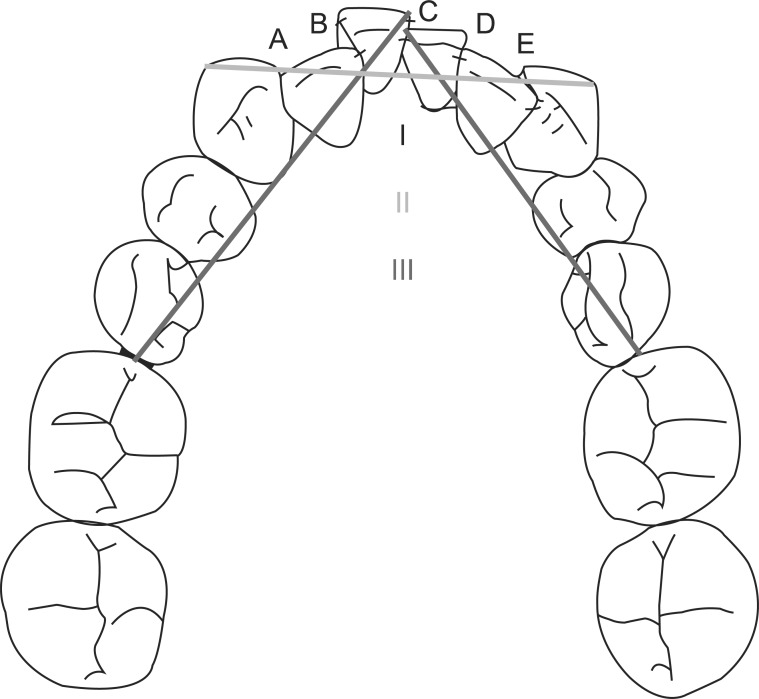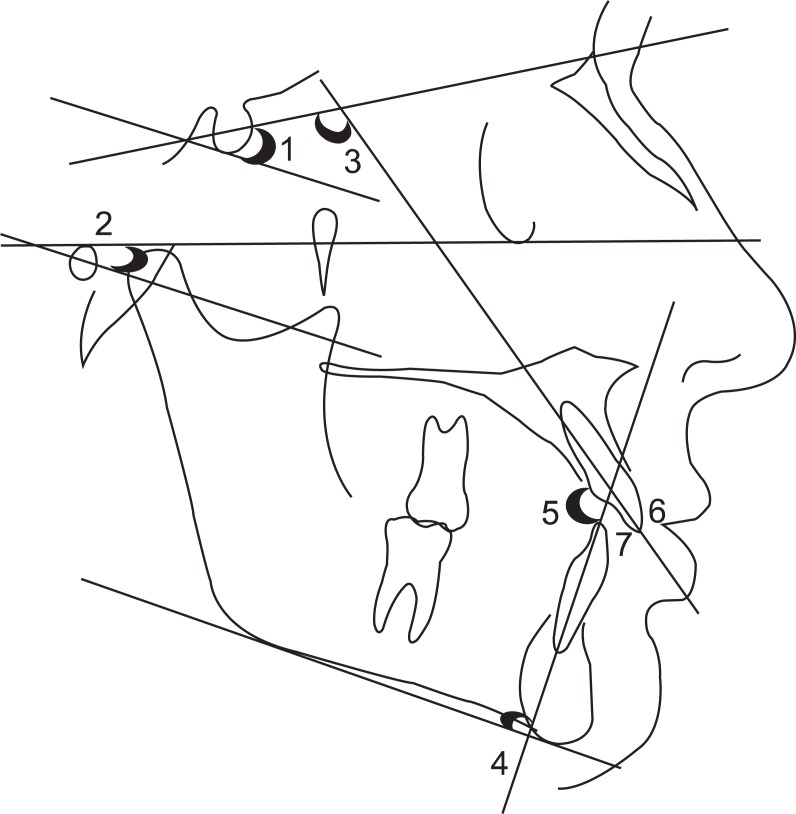Korean J Orthod.
2012 Oct;42(5):255-262. 10.4041/kjod.2012.42.5.255.
Comparison of retention characteristics of Essix and Hawley retainers
- Affiliations
-
- 1Department of Orthodontics, Faculty of Dentistry, Selcuk University, Konya, Turkey.
- 2Department of Orthodontics, Faculty of Dentistry, Cumhuriyet University, Sivas, Turkey. babacanhasan@yahoo.com
- 3Department of Orthodontics, Faculty of Dentistry, Suleyman Demirel University, Isparta, Turkey.
- 4Department of Orthodontics, Faculty of Dentistry, Gaziantep University, Gaziantep, Turkey.
- KMID: 1435401
- DOI: http://doi.org/10.4041/kjod.2012.42.5.255
Abstract
OBJECTIVE
We aimed to compare the retention characteristics of Essix and Hawley retainers.
METHODS
Adolescents undergoing fixed appliance treatment at 2 centers were recruited for this study. Twenty-two patients (16 women and 6 men) wore Essix retainers (Essix group) while 20 (14 women and 6 men) wore Hawley retainers (Hawley group). The mean retention time was 1 year, and the mean follow-up recall time for both groups was 2 years. Two qualified dental examiners evaluated the blind patient data. Maxillary and mandibular dental casts and lateral cephalograms were analyzed at 4 stages: pretreatment (T1), post-treatment (T2), post-retention (T3), and follow-up (T4).
RESULTS
The results revealed that Essix appliances were more efficient in retaining the anterior teeth in the mandible during a 1-year retention period. The irregularity index increased in both arches in both groups after a 2-year post-retention period. The mandibular arch lengths increased during treatment and tended to return to their original value after retention in both groups; however, these changes were statistically significant only in the Hawley group. Cephalometric variables did not show any significant differences.
CONCLUSIONS
The retention characteristics of both Essix and Hawley retainers are similar.
Keyword
Figure
Cited by 2 articles
-
A new type of clear orthodontic retainer incorporating multi-layer hybrid materials
Hyo-Won Ahn, Kyung A Kim, Seong-Hun Kim
Korean J Orthod. 2015;45(5):268-272. doi: 10.4041/kjod.2015.45.5.268.Effects of a new type of clear overlay retainer on occlusal contacts
Kyoung Yeon Kim, Hyo-Won Ahn, Seong-Hun Kim, Gerald Nelson
Korean J Orthod. 2017;47(3):207-212. doi: 10.4041/kjod.2017.47.3.207.
Reference
-
1. Moyers RE. Handbook of orthodontics for the student and general practitioner. 1973. 3rd ed. Chicago, London, Boca Raton: Year Book Medical Publishers.2. Hawley CA. A removable retainer. Int J Orthod Oral Surg. 1919; 2:291–298.
Article3. Sheridan JJ, Ledoux W, Mcminn R. Essix retainers: fabrication and supervision for permanent retention. J Clin Orthod. 1993; 27:37–45. PMID: 8478438.4. Proffit WR. Proffit WR, Fields HW, editors. Retention. Contemporary orthodontics. 1993. 2nd ed. St. Louis: Mosby Year Book;p. 617–631.5. Reitan K. Principles of retention and avoidance of posttreatment relapse. Am J Orthod. 1969; 55:776–790. PMID: 4890739.
Article6. Bearn DR. Bonded orthodontic retainers: a review. Am J Orthod Dentofacial Orthop. 1995; 108:207–213. PMID: 7625397.
Article7. Haydar B, Karabulut G, Ozkan S, Aksoy AU, Ciğer S. Effects of retainers on the articulation of speech. Am J Orthod Dentofacial Orthop. 1996; 110:535–540. PMID: 8922513.
Article8. Başçiftçi FA, Uysal T, Sari Z, Inan O. Occlusal contacts with different retention procedures in 1-year follow-up period. Am J Orthod Dentofacial Orthop. 2007; 131:357–362. PMID: 17346591.
Article9. Hichens L, Rowland H, Williams A, Hollinghurst S, Ewings P, Clark S, et al. Cost-effectiveness and patient satisfaction: Hawley and vacuum-formed retainers. Eur J Orthod. 2007; 29:372–378. PMID: 17702797.
Article10. Sauget E, Covell DA Jr, Boero RP, Lieber WS. Comparison of occlusal contacts with use of Hawley and clear overlay retainers. Angle Orthod. 1997; 67:223–230. PMID: 9188967.11. Lindauer SJ, Shoff RC. Comparison of Essix and Hawley retainers. J Clin Orthod. 1998; 32:95–97. PMID: 9709631.12. Rowland H, Hichens L, Williams A, Hills D, Killingback N, Ewings P, et al. The effectiveness of Hawley and vacuum-formed retainers: a single-center randomized controlled trial. Am J Orthod Dentofacial Orthop. 2007; 132:730–737. PMID: 18068589.
Article13. Little RM. The irregularity index: a quantitative score of mandibular anterior alignment. Am J Orthod. 1975; 68:554–563. PMID: 1059332.
Article14. Dahlberg G. Statistical methods for medical and biological students. 1940. New York: Interscience Publications.15. Joondeph DR. Graber TM, Vanarsdall RL, editors. Retention and relapse. Orthodontics: current principles and techniques. 2000. 3rd ed. St. Louis: Mosby;p. 985–1012.16. Bayram M, Ozer M. Mandibular incisor extraction treatment of a class I malocclusion with bolton discrepancy: a case report. Eur J Dent. 2007; 1:54–59. PMID: 19212499.
Article17. Ledvinka J. Vacuum-formed retainers more effective than Hawley retainers. Evid Based Dent. 2009; 10:47. PMID: 19561579.
Article18. Barlin S, Smith R, Reed R, Sandy J, Ireland AJ. A retrospective randomized double-blind comparison study of the effectiveness of Hawley vs vacuum-formed retainers. Angle Orthod. 2011; 81:404–409. PMID: 21261482.
Article19. Taner TU, Haydar B, Kavuklu I, Korkmaz A. Short-term effects of fiberotomy on relapse of anterior crowding. Am J Orthod Dentofacial Orthop. 2000; 118:617–623. PMID: 11113795.
Article20. Little RM, Wallen TR, Riedel RA. Stability and relapse of mandibular anterior alignment-first premolar extraction cases treated by traditional edgewise orthodontics. Am J Orthod. 1981; 80:349–365. PMID: 6945805.
Article21. Sadowsky C, Sakols EI. Long-term assessment of orthodontic relapse. Am J Orthod. 1982; 82:456–463. PMID: 6961816.
Article22. Little RM, Riedel RA, Artun J. An evaluation of changes in mandibular anterior alignment from 10 to 20 years postretention. Am J Orthod Dentofacial Orthop. 1988; 93:423–428. PMID: 3163221.
Article23. Shapiro PA. Mandibular dental arch form and dimension. Treatment and postretention changes. Am J Orthod. 1974; 66:58–70. PMID: 4525651.24. Glenn G, Sinclair PM, Alexander RG. Nonextraction orthodontic therapy: posttreatment dental and skeletal stability. Am J Orthod Dentofacial Orthop. 1987; 92:321–328. PMID: 3477951.
Article25. Melrose C, Millett DT. Toward a perspective on orthodontic retention? Am J Orthod Dentofacial Orthop. 1998; 113:507–514. PMID: 9598608.
Article26. Edman Tynelius G, Bondemark L, Lilja-karlander E. Evaluation of orthodontic treatment after 1 year of retention--a randomized controlled trial. Eur J Orthod. 2010; 32:542–547. PMID: 20080961.
Article27. Al Yami EA, Kuijpers-Jagtman AM, van't Hof MA. Stability of orthodontic treatment outcome: follow-up until 10 years postretention. Am J Orthod Dentofacial Orthop. 1999; 115:300–304. PMID: 10066979.
Article28. Yavari J, Shrout MK, Russell CM, Haas AJ, Hamilton EH. Relapse in Angle Class II Division 1 Malocclusion treated by tandem mechanics without extraction of permanent teeth: A retrospective analysis. Am J Orthod Dentofacial Orthop. 2000; 118:34–42. PMID: 10893471.
Article
- Full Text Links
- Actions
-
Cited
- CITED
-
- Close
- Share
- Similar articles
-
- A survey on retention practice among orthodontists in Malaysia
- Effects of thermoforming on the physical and mechanical properties of thermoplastic materials for transparent orthodontic aligners
- Comparison between fiber-reinforced polymers and stainless steel orthodontic retainers
- Prediction of CO2 retention with peak Inspiratory Flow in chronic obstructive Pulmonary disease.
- Accuracy of lingual fixed retainers fabricated using a CAD/CAM bending machine



